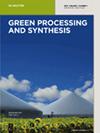Biosynthesis of silver nanoparticles on yellow phosphorus slag and its application in organic coatings
IF 3.8
4区 工程技术
Q2 CHEMISTRY, MULTIDISCIPLINARY
引用次数: 0
Abstract
This work concentrated on the decoration of AgNPs to yellow phosphorus slag (YPS) using both chemical (NaBH4) and biological (Areca catechu nut and Jasminum subtriplinerve leaf extracts) reducing agents, as well as its use as antibacterial and enhancement additives for organic coatings based on acrylic emulsion resin. It is the first study about the decoration of AgNPs on the surface of YPS using bio-reduction agents (A. catechu nut and J. subtriplinerve leaf extracts). The characteristics of YPS decorated by AgNPs (YPS@AgNPs) were determined using attenuated total reflectance infrared spectroscopy, scanning electron microscopy, X-ray diffraction, ultraviolet-visible spectroscopy and dynamic light scattering methods. To quantify the amount of AgNPs in YPS@AgNPs, atomic absorption spectroscopy was used. The results of YPS@AgNPs fabrication confirmed that the above green reduction agents had a higher efficiency and were more suitable than the chemical reduction agent (NaBH4). Moreover, the ability to inhibit the growth of bacteria strains of YPS@AgNPs using the J. subtriplinerve leaf extract as a reducing agent gave the best result among the three agents. In particular, the bactericidal activity of YPS@AgNPs against the new marine bacterium, Pseudomonas stutzeri B27, was evaluated, and it was found that YPS@AgNPs can inhibit the growth of an antibiotic-resistant bacterium, P. stutzeri B27. They enhance not only the mechanical properties but also the bactericidal ability of the water-borne acrylic resin coating.黄磷渣上银纳米粒子的生物合成及其在有机涂料中的应用
这项工作的重点是利用化学还原剂(NaBH4)和生物还原剂(Areca catechu nut 和 Jasminum subtriplinerve leaf extracts)在黄磷渣(YPS)上装饰 AgNPs,并将其用作基于丙烯酸乳液树脂的有机涂料的抗菌和增强添加剂。这是首次使用生物还原剂(儿茶坚果和次三叶芹叶提取物)在 YPS 表面装饰 AgNPs 的研究。研究采用衰减全反射红外光谱法、扫描电子显微镜法、X 射线衍射法、紫外可见光谱法和动态光散射法测定了被 AgNPs(YPS@AgNPs)装饰的 YPS 的特性。为了量化 YPS@AgNPs 中的 AgNPs 量,使用了原子吸收光谱法。YPS@AgNPs 的制备结果证实,上述绿色还原剂具有更高的效率,比化学还原剂(NaBH4)更合适。此外,以J. subtriplinerve叶提取物为还原剂的YPS@AgNPs抑制菌株生长的能力在三种还原剂中效果最好。特别是评估了 YPS@AgNPs 对新型海洋细菌 P. stutzeri B27 的杀菌活性,结果发现 YPS@AgNPs 可以抑制抗生素耐药菌 P. stutzeri B27 的生长。它们不仅增强了水性丙烯酸树脂涂层的机械性能,还增强了其杀菌能力。
本文章由计算机程序翻译,如有差异,请以英文原文为准。
求助全文
约1分钟内获得全文
求助全文
来源期刊

Green Processing and Synthesis
CHEMISTRY, MULTIDISCIPLINARY-ENGINEERING, CHEMICAL
CiteScore
6.70
自引率
9.30%
发文量
78
审稿时长
7 weeks
期刊介绍:
Green Processing and Synthesis is a bimonthly, peer-reviewed journal that provides up-to-date research both on fundamental as well as applied aspects of innovative green process development and chemical synthesis, giving an appropriate share to industrial views. The contributions are cutting edge, high-impact, authoritative, and provide both pros and cons of potential technologies. Green Processing and Synthesis provides a platform for scientists and engineers, especially chemists and chemical engineers, but is also open for interdisciplinary research from other areas such as physics, materials science, or catalysis.
文献相关原料
| 公司名称 | 产品信息 | 采购帮参考价格 |
|---|
 求助内容:
求助内容: 应助结果提醒方式:
应助结果提醒方式:


